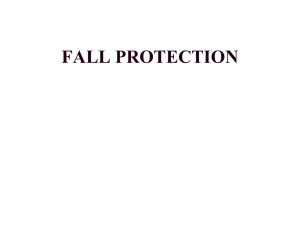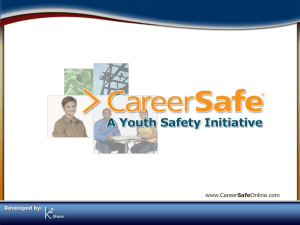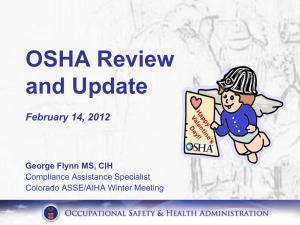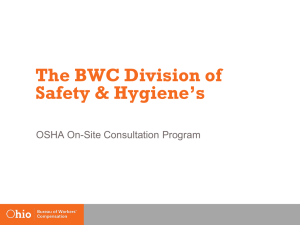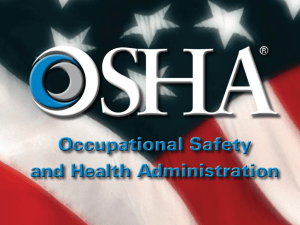Powerpoint PPTX
advertisement
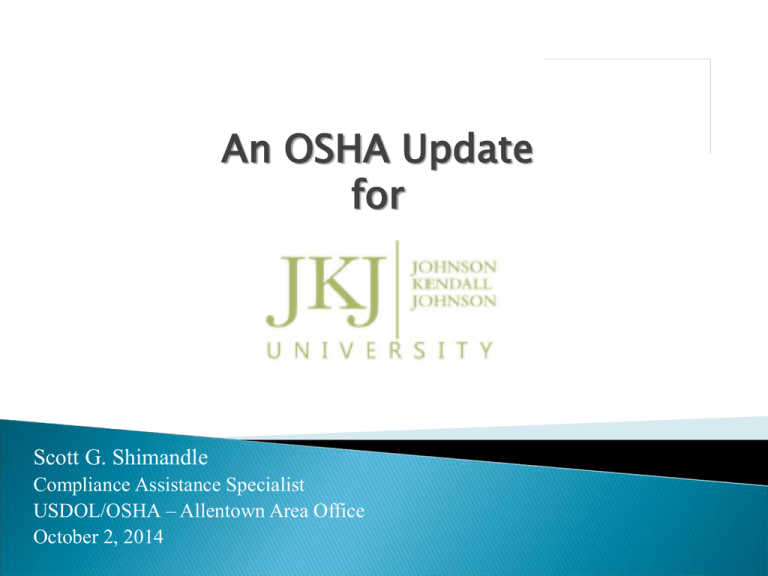
An OSHA Update for Scott G. Shimandle Compliance Assistance Specialist USDOL/OSHA – Allentown Area Office October 2, 2014 Disclaimer This information is intended to assist employers, workers, and others as they strive to improve workplace health and safety. While we attempt to thoroughly address specific topics, it is not possible to include discussion of everything necessary to ensure a healthy and safe working environment in a presentation of this nature. Thus, this information must be understood as a tool for addressing workplace hazards, rather than an exhaustive statement of an employer’s legal obligations, which are defined by statute, regulations, and standards. Likewise, to the extent that this information references practices or procedures that may enhance health or safety, but which are not required by a statute, regulation, or standard, it cannot, and does not, create additional legal obligations. Finally, over time, OSHA may modify rules and interpretations in light of new technology, information, or circumstances; to keep apprised of such developments, or to review information on a wide range of occupational safety and health topics, you can visit OSHA’s website at www.osha.gov. Presentation Overview OSHA’s Spring 2014 Unified Agenda ◦ Updates to OSHA’s Recordkeeping Rule Current Initiatives ◦ Nursing Home – NEP Overview Most Frequently Cited OSHA Violations ◦ National Top 10 ◦ Region III – Federal OSHA Offices Hazard Communication aka Globally Harmonized System (GHS) 3 OSHA’s Unified Agenda Spring 2014 4 Spring 2014 Unified Agenda: Pre-rule Stage Title RIN Bloodborne Pathogens 1218-AC34 Infectious Diseases 1218-AC46 Preventing Backover Injuries and Fatalities 1218-AC51 Combustible Dust 1218-AC41 Chemical Management and Permissible Exposure Limits (PELs) 1218-AC74 Process Safety Management and Prevention of Major Chemical Accidents 1218-AC82 Shipyard Fall Protection – Scaffolds, Ladders and Other Working Surfaces 1218-AC83 Communication Towers 1218-AC90 Emergency Response and Preparedness 1218-AC91 6 Spring 2014 Unified Agenda: Proposed Rule Stage Title RIN Occupational Exposure to Crystalline Silica 1218-AB70 Occupational Exposure to Beryllium 1218-AB76 Standards Improvement Project IV 1218-AC67 Amendments to the Cranes and Derricks in Construction Standard 1218-AC81 Clarification of Employer's Continuing Obligation to Make and Maintain an Accurate Record of Each Recordable Injury and Illness 1218-AC84 Cranes and Derricks in Construction: Operator Certification 1218-AC86 Updating OSHA Standards Based on National Consensus Standards Eye and Face 1218-AC87 Protection 7 Fall 2014 Unified Agenda: Final Rule Stage Title RIN Confined Spaces in Construction 1218-AB47 Electric Power Transmission and Distribution; Electrical Protective Equipment 1218-AB67 Walking Working Surfaces and Personal Fall Protection Systems (Slips, Trips, and Fall Prevention) 1218-AB80 Procedures for Handling Employee Retaliation Complaints Under the National Transit Systems Security Act; Surface Transportation Assistance Act; and Federal Railroad Safety Act – Corp. Criminal Fraud Accountability Act of 2002; the Consumer Financial Protection Act, the Seaman’s Protection, the FDA, Affordable Care Act, Moving Ahead for Progress in the 21st Century Act 1218-AC36 1218-AC53 1218-AC58 1218-AC79 1218-AC88 Occupational Injury and Illness Recording and Reporting Requirements--NAICS Update and Reporting Revisions 1218-AC50 Improve Tracking of Workplace Injuries and Illnesses 1218-AC49 Approved State Plans for Occupational Safety and Health 1218-AC76 8 OSHA’s Recordkeeping Revisions 9 OSHA Recordkeeping Changes Updated list of industries that are exempt from the requirement to routinely keep OSHA injury and illness records. ◦ Previous list used the Standard Industrial Classification (SIC) system from the Bureau of Labor Statistics (BLS) from 1996-1998. ◦ New list is based on North American Industrial Classification System (NAICS) from BLS from 20072009. ◦ Retains the exemption for any establishment with ten or fewer employees, regardless of their industry classification. 10 OSHA Recordkeeping Changes (cont’d) Rule also added (Table 2) Industries that include establishments newly required to keep records. 11 Industries That Include Establishments that Would Be Newly Required to Keep Records NAICS CODE Title of NAICS Code 3118 Bakeries and tortilla manufacturing 4411 Automobile dealers 4413 Automotive parts, accessories, and tire stores 4441 Building material and supplies dealers 4452 Specialty food stores 4453 Beer, wine, and liquor stores 4539 Other miscellaneous store retailers 4543 Direct selling establishments 5311 Lessors of real estate 5313 Activities related to real estate 5322 Consumer goods rental 5324 Commercial and industrial machinery and equipment rental and leasing 5419 Other professional, scientific, and technical services 12 Industries That Include Establishments that Would Be Newly Required to Keep Records NAICS CODE Title of NAICS Code 5612 Facilities support services 5617 Services to buildings and dwellings 5619 Other support services 6219 Other ambulatory health care services 6241 Individual and family services 6242 Community food and housing, and emergency and other relief services 7111 Performing arts companies 7113 Promoters of performing arts, sports, and similar events 7121 Museums, historical sites, and similar institutions 7139 Other amusement and recreation industries 7223 Special food services 8129 Other personal services 13 OSHA Recordkeeping Changes (cont’d) Rule expands the list of severe work-related injuries and illnesses that all covered employers must report to OSHA within 24 hours of learning about it. ◦ Inpatient hospitalizations of one or more employee ◦ All work-related amputations ◦ All work-related losses of an eye Retains the requirement to report all fatalities within 8 hours. 14 OSHA Recordkeeping Changes (cont’d) Amputations - The traumatic loss of a limb or other external body part. ◦ Amputations include a part, such as a limb or appendage, that has been severed, cut-off, amputated (either completely or partially); fingertip amputations with or without bone loss; medical amputations resulting from irreparable damage; and amputations of body parts that have since been reattached. 15 OSHA Recordkeeping Changes (cont’d) Do not have to “report” an event if it: ◦ Resulted from a motor vehicle accident on a public street or highway. Must report the event if it occurred within a construction work-zone. No change. ◦ Occurred on a commercial or public transportation system (airplane, subway, bus, ferry, streetcar, light rail, train). No change. ◦ Occurred more than 30 days after the work-related incident in the case of a fatality or more than 24 hours after the work-related incident in the case of an inpatient hospitalization, amputation, or loss of an eye. 16 OSHA Recordkeeping Changes (cont’d) Do not have to “report” an event if it: ◦ Employer do not have to report the inpatient hospitalization if it was for diagnostic testing or observation only. ◦ Inpatient hospitalization = formal admission to the inpatient service of a hospital or clinic for care or treatment. 17 18 OSHA’s Emphasis Programs Local/Regional Emphasis Programs National Emphasis Programs Special Emphasis Programs 20 Region III Local / Regional Emphasis Program (DE, DC, MD,** PA, VA,** WV) Directive Title 2014-01 (CPL 04) Regional Emphasis Program for the Oil and Gas Service Industry 2014-02 (CPL 04) Regional Emphasis Program Involving Exposure to Hexavalent Chromium (VI) 2014-03 (CPL 04) Regional Emphasis Program for Fall Hazards in the Construction Industry 2014-04 (CPL 04) Regional Emphasis Program – Silica 2014-07 (CPL 04) Local Emphasis Program for Health Hazards in Metal Fabrication Except Structural 2014-11 (CPL 04) Local Emphasis Program for Logging in West Virginia 2014-20 (CPL 04) Local Emphasis Program for Ship/Boat Building and Repair 2014-32 (CPL 04) Regional Emphasis Program for High Level Noise 2014-05 Regional Emphasis Program for Tree Trimming and Clearing Operations OSHA Emphasis Programs National Emphasis Programs (NEP) COMBUSTIBLE DUST - OSHA Instruction CPL 03-00-008 National Emphasis Program on Combustible Dust (Reissued) (Date: 03/11/2008) HAZARDOUS MACHINERY - OSHA Instruction CPL 03-00-003 National Emphasis Program on Amputations (Date: 10/27/2006) HEXAVALENT CHROMIUM - OSHA Instruction CPL 02-02-076 National Emphasis Program - Hexavalent Chromium (Date: 02/23/2010) LEAD - OSHA Instruction CPL 03-00-009 National Emphasis Program on Lead (Date: 08/14/2008) PRIMARY METALS INDUSTRIES - OSHA Instruction CPL 03-00-013 Primary Metal Industries (Date: 05/19/2011) 22 OSHA Emphasis Programs (cont’d) National Emphasis Programs (cont’d) PROCESS SAFETY MANAGEMENT - CPL 03-00-014 PSM Covered Chemical Facilities National Emphasis Program (Date:11/29/2011) SILICA - OSHA Instruction CPL 03-00-007 National Emphasis Program on Crystalline Silica (Date: 01/24/2008) NURSING AND RESIDENTIAL CARE FACILITIES - OSHA Instruction CPL 03-00-016 National Emphasis Program on Nursing and Residential Care Facilities (Date: 04/05/2012) ISOCYANATES - OSHA Instruction CPL 03-00-017 National Emphasis Program – Occupational Exposure to Isocyanates (Date: 06/20/2013) SHIPBREAKING - OSHA Instruction CPL 03-00-012 National Emphasis Program on Shipbreaking (Date: 11/04/2010) 23 OSHA Emphasis Programs (cont’d) Special Emphasis Programs FEDERAL AGENCIES - OSHA Notice 11-04 (FAP 01) Federal Agency Targeting Inspection Program (FEDTRG12) (Date:12/23/2011) TRENCHING & EXCAVATION - OSHA Instruction CPL 02-00069 [CPL 2.69] Special Emphasis Program on Trenching and Excavation (Date: 9/19/1985) 24 Overview of Nursing Home National Emphasis Program Nursing and Residential Care Facilities DIRECTIVE NUMBER: CPL 03-00-016 EFFECTIVE DATE: April 5, 2012 Background (cont’d) NEP is focusing on: ◦ Ergonomic stressors (e.g., relating to resident handling) ◦ Exposure to blood and other potentially infectious materials ◦ Exposure to tuberculosis ◦ Workplace violence ◦ Slips, trips, and falls 26 Inspection Procedures Recordkeeping Ergonomics: MSD Risk Factors Relating to Resident Handling Slips, Trips and Falls Bloodborne Pathogens Tuberculosis (TB) Workplace Violence Other Hazards ◦ Methicillin-resistant Staphylococcus aureus (MRSA) and other multi-drug resistant organisms (MDROs) ◦ Hazard Communication Appendices Appendix A – CSHO Quick Reference for Data Collection Appendix B – Release and Consent Form Appendix C – Reference Material for Nursing Home National Emphasis Program Appendix D – Sample 5(a)(1) AVD for Resident Handling Hazards Appendix E – Sample 5(a)(1) AVD for MRSA Exposure OSHA’s Areas of Focus and Initiatives 29 Current Agency Focus Areas/Initiatives Strengthening our Whistleblower Program Hospitals and Healthcare Oil and Gas Drilling Ergonomics Crystalline Silica Reducing Exposures to Hazardous Chemicals Protecting Vulnerable Workers - English As a Second Language Employees Current Agency Focus Areas/Initiatives Falls in Construction Heat Stress Globally Harmonized System Workplace Violence Highway/Roadway Work Zone Safety Protecting Temporary and Contract Workers Isocyanates 32 Top OSHA Violations 33 Top 10 Violations for the Nation* in FY’14 (*Federal OSHA) 1. Fall Protection in Construction (1926.501) 2. Hazard Communication (1910.1200) 3. Scaffolding in Construction (1926.451) 4. Respiratory Protection (1910.134) 5. Lockout/Tagout (1910.147) 6. Powered Industrial Trucks (1910.178) 7. Electrical – Wiring Methods (1910.305) 8. Ladders in Construction (1926.1053) 9. Machine Guarding (1910.212) 10.Electrical – General Requirements (1910.303) 34 Top 20 Violations in General Industry issued since 2012 (Region III) 1. 2. 3. 4. 5. 6. 7. 8. 9. 10. Hazard Communication (1910.1200) Respiratory Protection (1910.134) Control of Hazardous Energy (LO/TO) (1910.147) Occ. Exposure to Bloodborne Pathogens (1910.1030) Electrical Equipment – General (1910.303) Electrical Wiring & Comp. – General (1910.305) Powered Industrial Trucks – (1910.178) Machine Guarding – General (1910.212) Occupational Noise (1910.95) Personal Protective Equipment (1910.132) 35 Top 20 Violations in General Industry issued since 2012 (Region III) 11. 12. 13. 14. 15. 16. 17. 18. 19. 20. Guarding Floor and Wall Openings (1910.23) Portable Fire Extinguishers (1910.157) Abrasive Wheel Machinery (1910.215) Walking-Working Surfaces – General (1910.22) Mtnc & Operational Features for Exit Routes (1910.37) Section 5(a)(1) of OSH Act Mech. Power-Transmission Apparatus (1910.219) Medical Services and First Aid (1910.151) Process Safety Mgmt. of HHC (1910.119) Eye and Face Protection (1910.133) 36 Top 10 Violations in Construction issued since 2012 (Region III) 1. 2. 3. 4. 5. 6. 7. 8. 9. 10. Duty to have Fall Protection (1926.501) Hazard Communication (1910.1200) Scaffolds – General Requirements (1926.451) Respiratory Protection (1910.134) Control of Hazardous Energy (LO/TO) (1910.147) Ladders (1926.1053) Fall Protection – Training Requirements (1926.503) Occ. Exposure to Bloodborne Pathogens (1910.1030) Electrical Equipment – General (1910.303) Electrical Wiring & Comp. – General (1910.305) 37 Standards Overview Lockout/Tagout Energy Control Procedures Periodic Inspections Training and Communication Adequate Hardware Hazard Communication Written Plan – General Information & Training Labeling of Containers MSDS (SDS)-Maintenance 38 Standards Overview Electrical Wiring Methods Use of flexible cords Conductors into boxes Identification, splices… Covers and canopies Temporary Wiring Powered Industrial Trucks Safe Operation Refresher Training/Eval Certification Truck Inspections Maintenance 39 Standards Overview Machine Guarding Types of Guarding Point of Operation Guarding Barrels, Containers and Drums Exposure of Blades Anchoring of fixed equipment/machinery Respiratory Protection Written Program Medical Evaluations Fit-Testing Training Use and Selection of Respirator 40 Standards Overview Electrical - General Installation and Use Space around equip. Guarding of live parts Marking of services, … Free of recognized hazards Others 41 Construction Standards Overview Fall Protection Residential Construction Unprotected Edges/Sides Roofing Work–Low Slope Steep Roofs Protection from holes and skylights Scaffolds Fall Protection Decking/Planking Access Foundation/Base Guardrails 42 Construction (cont’d) Ladders Others Not Securing or Extending Not being used as designed Top step being used Broken ladder being used Carrying loads which could lead to a fall 43 Hazard Communication PPT-016-03 2 General Standard Requirements • A written program to cover issues of chemical safety and hazard communication (HAZCOM). • Labels to identify each chemical. • Material Safety Data Sheets (MSDSs) (now SDSs under the Globally Harmonized System: GHS). • Employee training on SDS information and safe chemical procedures and practices. 3 Why did OSHA align the HCS with GHS? A common, coherent approach to classifying and communicating chemical hazards. ◦ Harmonized definitions of hazards ◦ Specific criteria for labels ◦ Harmonized format for safety data sheets Modifications/Notable changes Using a “specification” approach rather than a “performance-oriented” approach ◦ “Hazard classification” rather than “hazard determination” Labels are more defined and will now require: ◦ ◦ ◦ ◦ ◦ ◦ Product identifier Pictogram Signal word Hazard statement(s) Precautionary statement(s) Name, address, and telephone number “Safety data sheet” (rather than “Material Safety Data Sheet”) uses a 16-section format. Organization of the Final Rule a) Purpose b) Scope and Application c) Definitions d) Hazard Classification e) Written Hazard Communication Program f) Labels and Other Forms of Warning g) Safety Data Sheets h) Employee Information and Training i) Trade Secrets j) Effective Dates Appendices A–F Appendices • • • • • • Appendix A, Health Hazard Criteria (Mandatory) (NEW) Appendix B, Physical Hazard Criteria (Mandatory) (NEW) Appendix C, Allocation of Label Elements (Mandatory) (NEW) Appendix D, Safety Data Sheets (Mandatory) (NEW) Appendix E, Definition of “Trade Secret” (Mandatory) Appendix F, Guidance for Hazard Classifications re: Carcinogenicity (Non-Mandatory) (NEW) Written Plan • • • • • How SDS filing requirements are being met Type of labeling system being used Detailed information on training and compliance Methods to inform employees of nonroutine tasks and safe procedures Methods to inform outside contractors of the HAZCOM program Contractor Requirements • Contractors must abide by the applicable provisions of federal, state and local hazard communication and right to know laws/regulations. • Any contractor found not meeting the provisions of the laws or contractor requirements may be required to cease work until compliance is achieved. Label Requirements Chemical manufacturer, importer or distributor must ensure each container of hazardous chemicals leaving the workplace is labeled, tagged or marked with: Product identifier Signal word Hazard statement(s) Pictogram(s) Precautionary statement(s) Name, address, and phone number of the responsible party Labels (cont’d) Small packages ◦ No exemptions for small packages ◦ OSHA provides practical accommodations on a case-by-case basis Pictograms ◦ Blank pictograms are not permitted on a label No size requirements for labels ◦ Must be legible Workplace Labeling No change to general workplace labeling requirements HMIS labels and NFPA ratings, by themselves, are not sufficient for workplace labels ◦ NFPA rating systems used for emergency response Before the June 1, 2015 deadline, employers may use labels compliant with HCS 1994. HCS Pictograms and Hazards Label Example Pictograms Hazard Statements Product Identifier Signal Word Precautionary statements Name, address and phone number 16-Section Safety Data Sheet 1. 2. 3. 4. 5. 6. 7. 8. 9. Identification of the substance or mixture and of the supplier Hazards identification Composition/information on ingredients Substance/Mixture First aid measures Firefighting measures Accidental release measures Handling and storage Exposure controls/personal protection Physical and chemical properties 10. 11. 12. 13. 14. 15. 16. Stability and reactivity Toxicological Ecological information (non mandatory) Disposal considerations (non mandatory) Transport information (non mandatory) Regulatory information (non mandatory) Other information including information on preparation and revision of the SDS Effective Dates Covered employers must complete all training regarding the new label elements and Safety Data Sheet (SDS) format by December 1, 2013. Provisions for preparation of new labels and SDSs by June 1, 2015. ◦ However, distributors will have an additional 6 months (December 1, 2015) to distribute containers with manufacturer’s labels in order to accommodate those they receive very close to the compliance date. Employers will also be given an additional year (June 1, 2016) to update their hazard communication programs or any other workplace signs, if applicable. 59 Questions? 60 ALLENTOWN AREA OFFICE USDOL/OSHA Allentown Area Office Stabler Corporate Center 3477 Corporate Parkway, Suite 120 Center Valley, PA 18034 Office Phone: (267) 429-7542 Fax: (267) 429-7567


